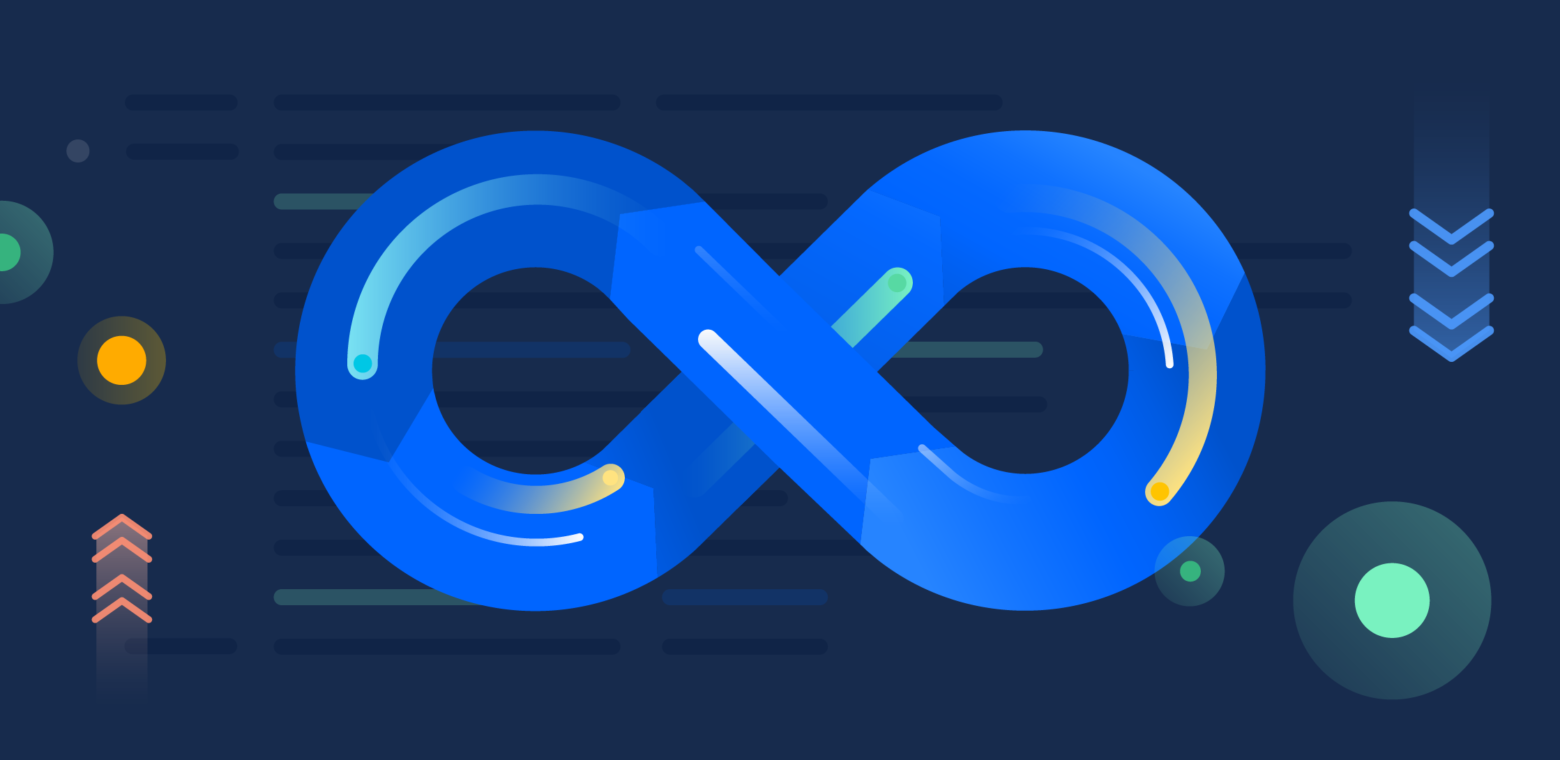Our mission is to unleash the potential of all teams by harnessing the power of collaboration tools and practices. This is particularly true for teams practicing DevOps, which is all about unlocking collaboration between development, IT operations, and business teams.
However, this increased collaboration can come at a cost to developers. Instead of coding and building innovative solutions, developers can end up spending a big chunk of their day integrating multiple tools, updating work status, and sharing it with other teams.
This came out loud and clear in the DevOps Trends Survey we conducted earlier this year. We found that the same practices that were supposed to make developers’ lives easier were in fact causing new kinds of pain. Too many disconnected tools, manual processes, and constantly changing collaboration practices are blocking developers from reaching the full promise of DevOps.
90 percent of teams reported that DevOps had a positive impact on the business, but there’s also a danger that it can take time away from innovation, with 84 percent saying that they faced barriers to implementation.
Today, we are announcing 12 new features, automations and integrations to help developers take their time back and ship better code, faster. Less context switching. Fewer meetings. Fewer pings from IT about security incidents. Just more time to code and deliver value to customers.
We’re helping developers focus on their code as we uniquely connect development, IT operations, and business teams with automation that spans our products and third-party tools. With Jira as the backbone and ultimate source of truth, Atlassian unifies all of DevOps work and reduces collaboration overload.
Read on to learn more about how we’re helping developers get more productive.
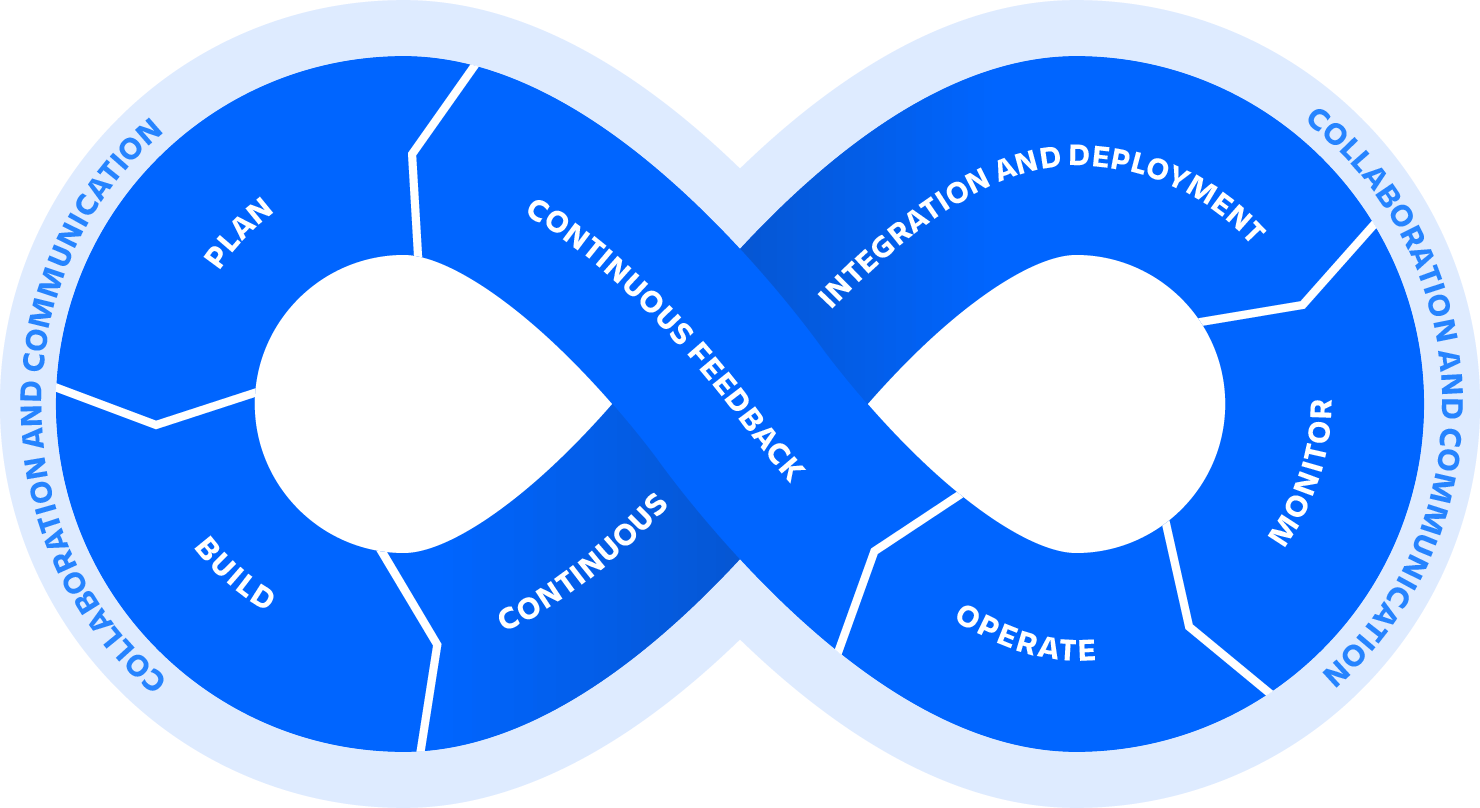

Plan and track projects right in the context of your code
We believe that the DevOps toolchain is not a one-sized-fits-all approach. DevOps is a toolbox across different applications and teams, and the developer knows best when it comes to what tools to use or how many. But with that flexibility comes a critical need for coordination of the work. Our survey found that an increasing number of DevOps teams are saying they need 5+ tools to understand project status. IT Ops and Business teams that aren’t closely working in these tools need to know what’s happening and when. That’s where Jira comes in. Jira automatically unifies work across teams and tools.
We’ve built deep integrations between Jira Software Cloud and Bitbucket Cloud, GitHub, and GitLab so that issue tracking and project updates happen right where you code, automatically. No need to go back to Jira. And your project manager won’t have to ping you for updates and interrupt your coding flow, because your project board will automatically update based on your work in Bitbucket, GitHub, or GitLab.
- The new Your Work dashboard in Bitbucket Cloud has been expanded to include your assigned Jira issues so you can quickly move from one task to the next, without jumping between tools. Inside each repository, you’ll also soon see a new team-level view of connected projects and issues inside the “Jira issues” tab.
- In Jira Software Cloud, we’ve enhanced the automation capabilities with powerful new DevOps Automation Triggers. With just a few clicks, you can create automation rules to keep your work in sync with development activities, with triggers from commit or pull request activity in any connected code repository. At their most basic, you can automatically update the status of the related Jira issues, but these new automations also allow more complex rules like reassigning Jira issues for QA or code review, or even sending a message to your team’s Slack channel about new PRs. These automation rules work with Bitbucket Cloud, GitHub, GitLab, and any other code repository that integrates with Jira Software Cloud.
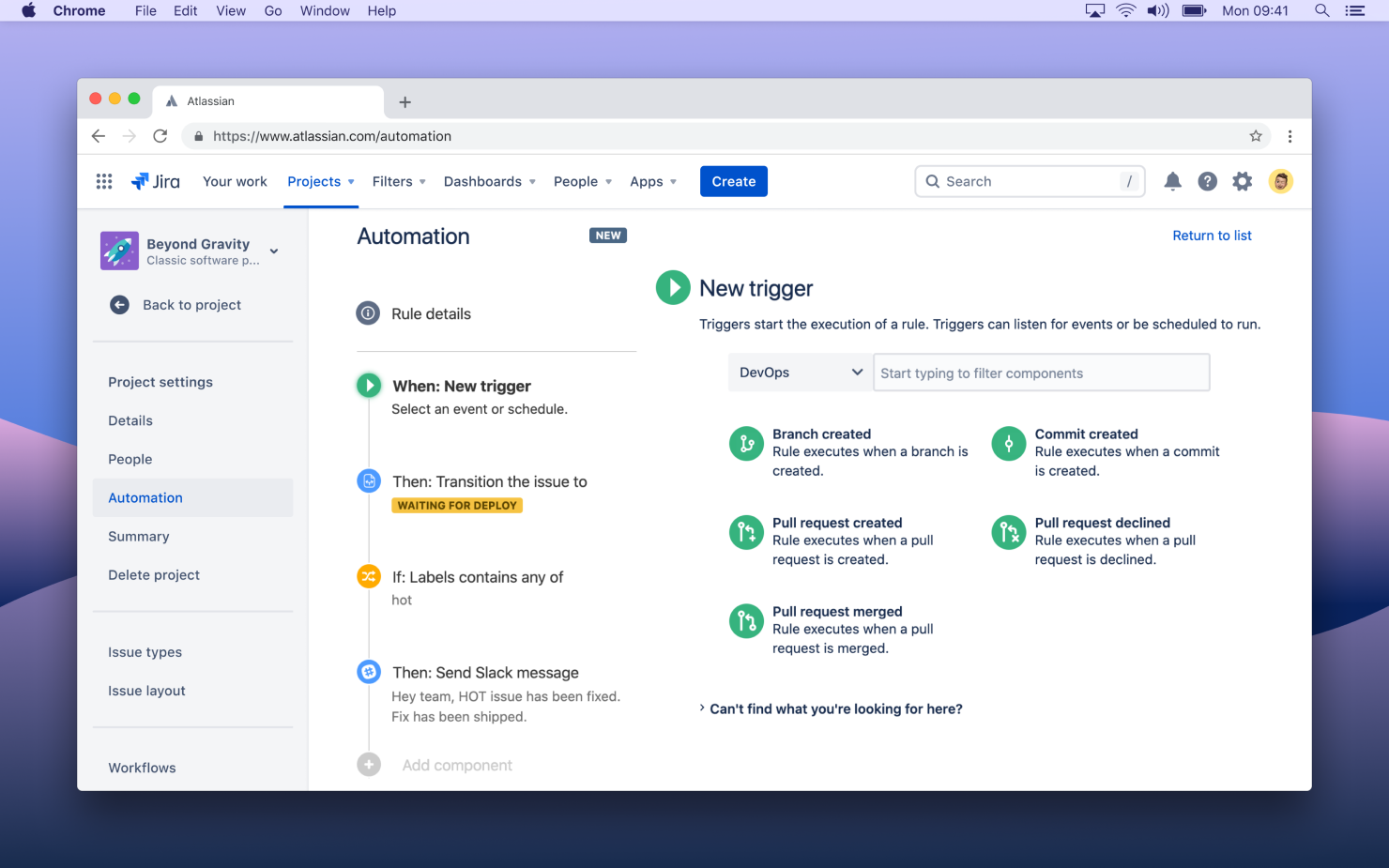
Learn more about how teams that use Jira and Bitbucket release 14% more often.

Review, test, and deploy code without losing your place
Every team wants the best possible tools for writing and reviewing code, and with Bitbucket Cloud, we’ve got you covered. We want to maximize your developers’ productivity on the most important tasks they do each day – writing and reviewing code.
Whether you prefer working in Bitbucket or your IDE, our goal is to keep you in the flow, and reduce unnecessary bounces between your tools.
- Bitbucket Cloud’s new Pull Request Experience delivers an innovative design that makes it easier and faster to review your code changes. New features like consolidated list of tasks, integrated Jira issue creation, and activity feed filters mean developers can complete their code reviews faster, and efficiently juggle multiple pull requests at once.
- The Atlassian VS Code integration brings your entire dev pipeline into your editor, with your task list from Jira Software Cloud, a complete code review experience, and CI/CD tracking from Bitbucket Pipelines. If you haven’t already seen it, try out the VS Code extension today.

Ship fast without breaking things
DevOps teams are trying to accelerate their pipeline through automation and “shifting left” of manual checks into the CI/CD process. To help with this, we’ve brought scanning and quality reports into the Bitbucket Cloud code review experience so reviewers are alerted of potential issues before anything gets pushed through to production. You can also try out our new automated change management, which connects your CI/CD pipeline with painless change approvals in Jira Service Desk Cloud.
- Code Insights in Bitbucket Cloud lets you bring the best DevOps scanning, testing and analysis tools into your code review process, including Mabl for test automation and Sentry for automated monitoring. Our new DevSecOps integration with Snyk is especially important, as Snyk can scan and highlight critical security vulnerabilities early – before they turn into a Sev-1 security incident. All these integrations are also built on an open API, so you can extend Bitbucket Cloud with additional code reports for your own tools.
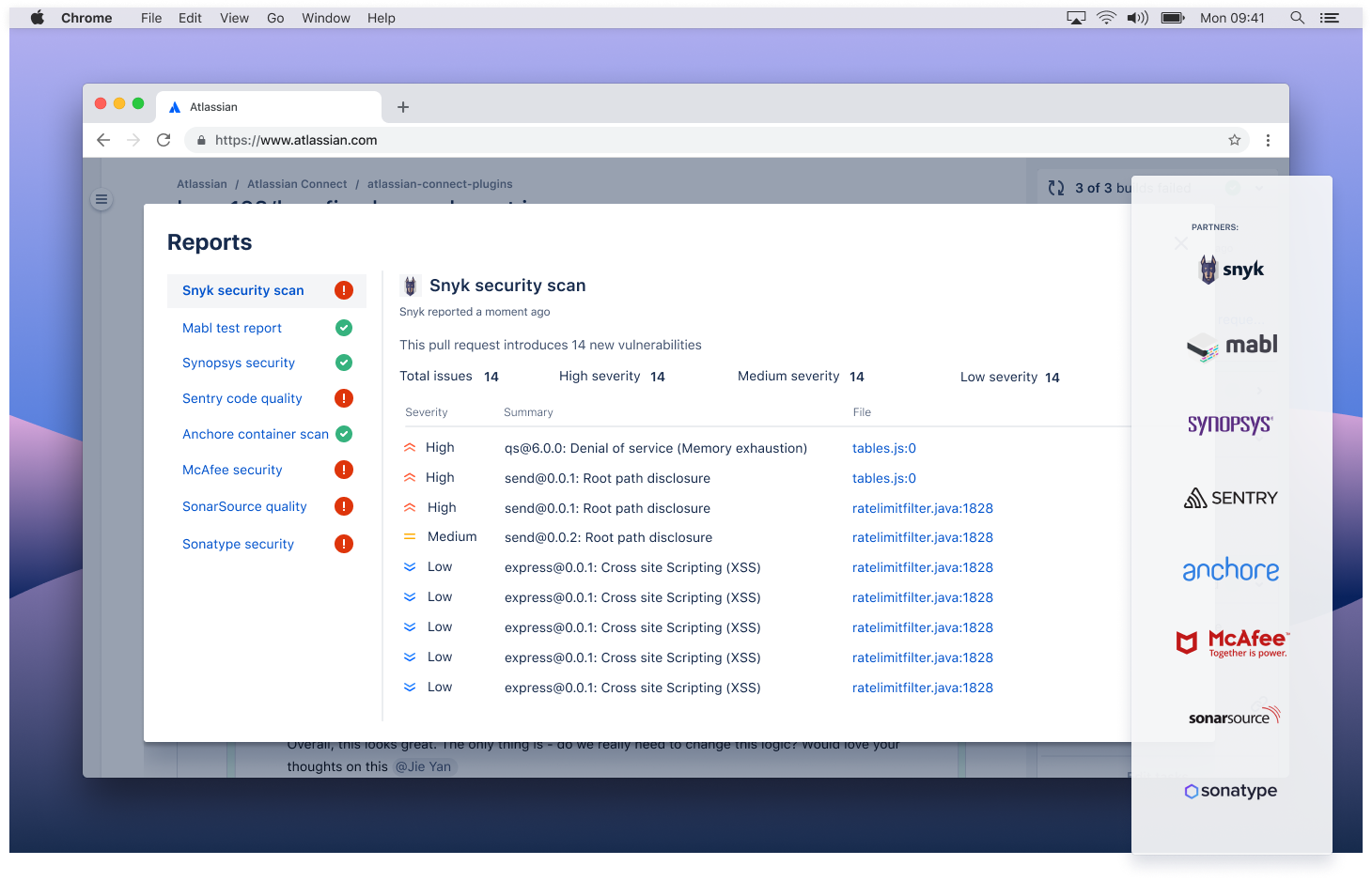
- Automated change management with Jira Service Desk Cloud and Bitbucket Pipelines (currently in early access) will pause your CI/CD process, create a change request in Jira Service Desk, and then trigger the deployment once it is approved:
- Our Risk Assessment Engine in Jira Service Desk Cloud quickly scores the risk of a change and auto-approves and deploys low-risk changes.
- Our Change Management View in Jira Service Desk Cloud streamlines the approval process for high-risk changes by pulling all of the information together in traceable change requests the team can review and manually approve if necessary.
- Automated change management supports Bitbucket Pipelines, Jenkins, Circle CI, and Octopus Deploy.
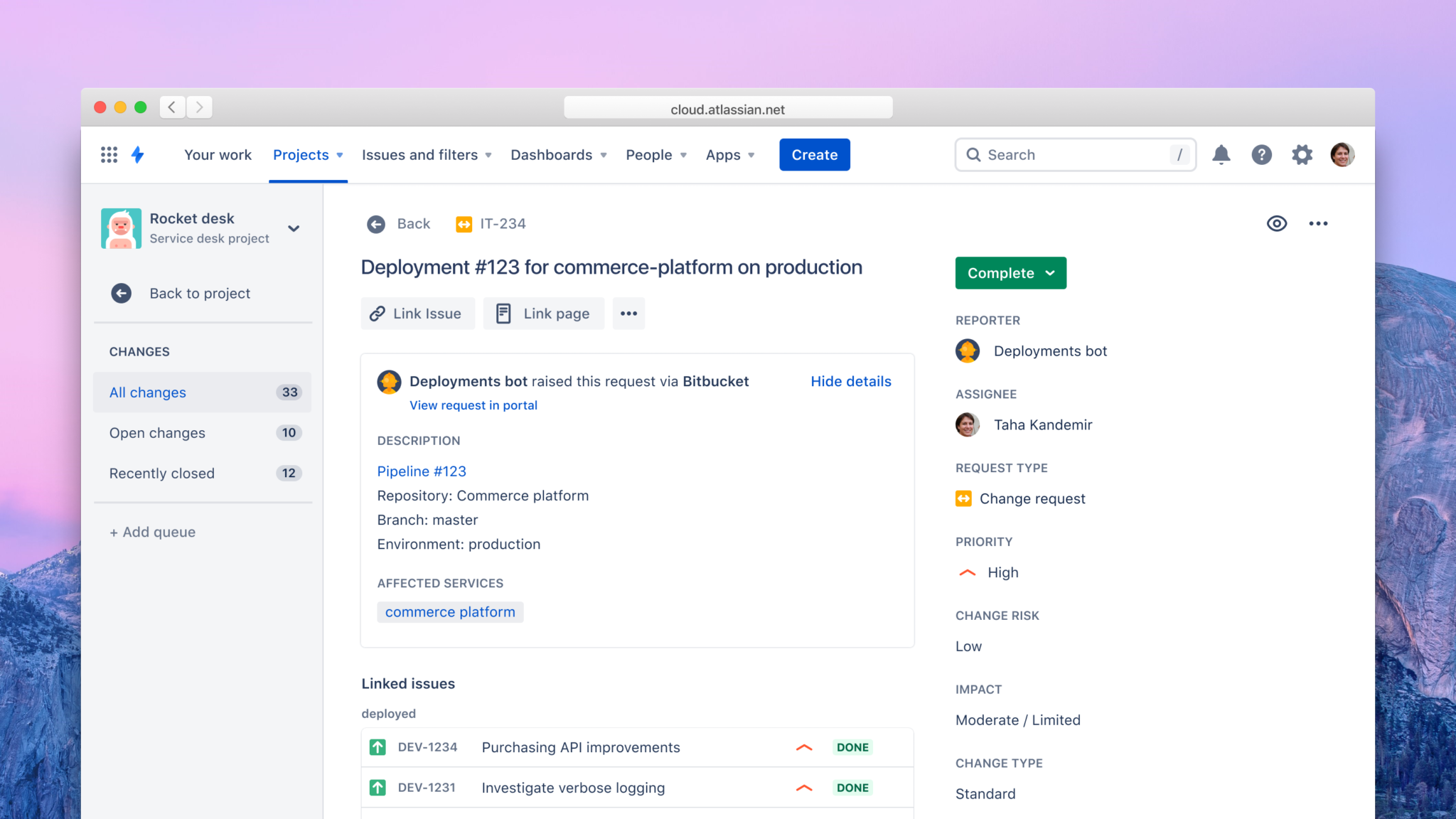

Mitigate alert fatigue and resolve incidents faster
When incidents happen, the key to fast resolution is determining the cause of the problem quickly. And as your teams adopt DevOps and automate their deployment processes, change-related failures become increasingly common. When you’re woken up to deal with an outage, wouldn’t it be great to know whether a recent code change caused the issue, and immediately be able to get help from the right developer?
For most teams today, this requires advanced detective work, trawling through Git history and Jira tickets. We knew there had to be a better way. Opsgenie’s brand new, deep integration into Jira Software Cloud and Bitbucket Cloud helps teams shortcut this whole process, giving the first responders an audit trail for recent deployments and their related Jira tickets.
- Our Opsgenie and Bitbucket Cloud integration centralizes all alerts and filters out the noise to make sure the right issues are being picked up, the right people are being alerted, and the right action is taken. With the Incident Investigation Dashboard, teams can look at the deployment that happened right before the incident, add it as a potential cause, and contact the developer who made the change so that they can roll it back and resolve the incident.


DevOps is about tools and practices/culture
Successful DevOps implementation doesn’t end at connecting the tools. Most DevOps practitioners agree, citing people and culture as the top factor in successfully implementing. To strike this balance, we’ve created a new destination for you to learn and share DevOps best practices.
- Our resources hub shares guidance on how to connect tools with practices and cultivate a world-class DevOps culture. The hub will include:
- DevOps Community (featuring exclusive AMAs with DevOps thought leaders)
- DevOps Confluence templates (to improve DevOps rituals and set long-term team goals)
- DevOps Guides (on how to connect tools like Jira with industry best practices like CI/CD)
We’ve also extended our automated integrations to your go-to communication tools. For your day-to-day, our Slack integration and Statuspage integrations can help you adopt DevOps best practices in both your internal and external communications.
Get started with Atlassian DevOps
Ready to simplify your DevOps workflow? Learn more about how we think about DevOps at Atlassian, discover best practices to improve how your team is performing, or just get started on your journey by signing up today.
Starting work from Jira Software Cloud? Stay in flow with the code from your board.
We know developers spend most of their time in their Git tool or in the IDE, but when you do log into Jira, we’ve made it easier to understand projects in the context of code. Here are some additional updates we’ve added to more closely align your Jira view with the way you work:
– Developer Tool Summary & Release Management in Jira Native Apps: We’ve added a new DevTools summary and Release Hub into our Jira native apps for iOS, Android, and desktop. Visualize both first- and third-party developer tool integrations in our native apps, and manage releases anytime, anywhere.
– Code in Jira (Coming soon): Connect Bitbucket to Jira and automatically see which repositories your team works across right within the new Code view in Jira. With Code as a top-level project navigation item your team can get visibility of the code that is actively being worked on without needing to leave Jira.
– Deployments in Jira (Coming soon): View CI/CD deployment information and pre-planned releases right from within Jira Software. Visualize the progress of work as it moves through the deployment pipeline. With the new view, you’ll never have to worry about missing the status on a change ever again. Simply check the view to get clear visibility into where a change is in the pipeline and when it will reach customers.
